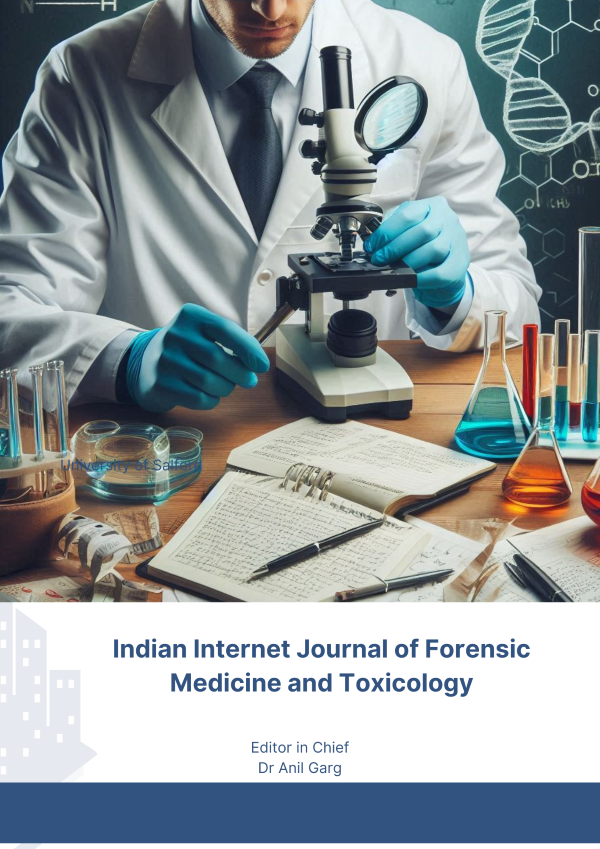A Study of Electrocution-Related Deaths: An Autopsy-Based Analysis at SMS Medical College and Hospital, Jaipur During the year 2023-24
DOI:
https://doi.org/10.48165/iijfmt.2025.23.2.1Keywords:
Electrocution deaths, Medico-legal autopsy, Low-voltage electrocution, Rural predominance, Entry and exit wounds.Abstract
Background: Electrocution is a largely preventable cause of mortality but continues to be a significant medico-legal and public health issue in India. It commonly occurs due to accidental contact with live wires, faulty appliances, or unsafe occupational practices, with suicidal and homicidal cases being rare. Aim: To analyze the demographic profile, injury patterns, and medico-legal aspects of electrocution-related deaths at SMS Medical College, Jaipur, during 2023–2024. Methodology: This observational study was conducted from November 2023 to October 2024 in the Department of Forensic Medicine, S.M.S. Medical College, Jaipur. A total of 100 medico-legal autopsy-confirmed cases of electrocution deaths were included after ethical approval and consent from legal heirs. Cases suspected but not confirmed on postmortem and decomposed bodies were excluded. Data were analyzed with respect to demographic details, site of injury, wound characteristics, voltage, associated burns, and cause of death. Result:Males predominated (89%) with only 11% females. The most affected age group was 20–29 years (37%), followed by 30–39 years (26%). Rural victims constituted 55% of cases. Hindus formed the majority (82%), reflecting regional demographics. The limbs were the most common sites of injury (lower limb 77%, upper limb 62%). Entry and exit wounds were noted in 52%, while 8% showed no external marks. Low voltage exposure accounted for 68% of deaths, and flame burns were seen in 48% of cases. Septicemia was the leading cause of death (55%), followed by shock due to electrocution (38%). Conclusion: Electrocution deaths predominantly affect young rural males engaged in high-risk occupatio ns. Most fatalities result from low-voltage exposure and septicemia following burns. The findings emphasize the importance of public awareness, enforcement of workplace safety standards, and meticulous medico-legal autopsy to prevent and correctly identify electrocution deaths.
Downloads
References
Patel, J. P., & Gupta, B. D. (2010). Profile of deaths due to electrocution: An autopsy-based study. Journal of Indian Academy of Forensic Medicine, 32(1), 49–51.
Aggarwal, A., Kaur, B., & Dhattarwal, S. K. (2005). Fatal electrocution in North Delhi – A retrospective study. Medico-Legal Update, 5(2), 41–44.
Letha, S., & Rajan, J. (2016). Epidemiological profile of electrocution deaths in Coimbatore. Indian Journal of Forensic Medicine and Toxicology, 10(1), 111–114.
Prasad, C. S. B. R., & Rajesh, D. R. (2017). An autopsy study of electrocution deaths in Ballari, Karnataka. International Journal of Health Sciences and Research, 7(5), 123–127.
Vij, K. (2018). Textbook of Forensic Medicine and Toxicology: Principles and Practice (8th ed.). New Delhi: Elsevier.
National Crime Records Bureau. (2022). Accidental Deaths and Suicides in India – 2021. New Delhi: Ministry of Home Affairs, Government of India.
Sharma, S., Sharma, A., & Mathur, P. N. (2023). Electrocution deaths: An autopsy-based study at a tertiary care hospital in Rajasthan. Indian Journal of Forensic Medicine and Toxicology, 17(3), 205–210.
Khan, N., Dubey, A., & Mishra, A. (2025). A retrospective study of electrocution deaths in Bhopal region. Indian Journal of Forensic Medicine and Pathology, 18(1), 45–49.
Mesina, C., & Ibrahim, A. (2025). Mechanism of death in electrocution: A forensic review. Forensic Science International, 381, 111–118.
Prasad, K., Vergia, S. V., Johry, A., et al. (2025). Forensic analysis of electrical injury patterns: A study of electrocution fatalities at SMS Medical College Jaipur. Indian Journal of Forensic Medicine and Toxicology, 19(1), January–March.

